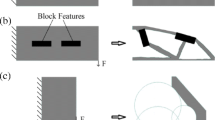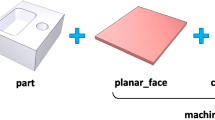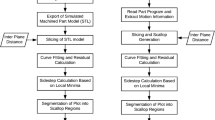Abstract
This paper presents a new concept of feature for freeform surface machining that defines the changes in feature status during real manufacturing situations which have not been sufficiently addressed by current international standards and previous research in feature technology. These changes are multi-perspective, including (i) changes in depth-of-cut: the geometry of a feature in the depth-of-cut direction changes during different machining operations such as roughing, semi-finishing and finishing; (ii) changes across the surface: a surface may be divided into different machining regions (effectively sub-features) for the selection of appropriate manufacturing methods for each region such as different cutting tools, parameters, set-ups or machine tools; and (iii) changes in resources or manufacturing capabilities may require the re-planning of depth-of-cuts, division of machining regions and manufacturing operations (machines, tools, set-ups and parameters). Adding the above dynamic information to the part information models in current CAD systems (which only represent the final state of parts) would significantly improve the accuracy, efficiency and timeliness of manufacturing planning and optimisation, especially for the integrated NC machining planning for complex freeform surfaces. A case study in an aircraft manufacturing company will be included in this paper.
Similar content being viewed by others
References
Lasemi A, Xue DY, Gu PH (2010) Recent development in CNC machining of freeform surfaces: a state-of-the-art review. Comput Aided Des 42:641–654
Wang LH, Holm M, Adamson G (2010) Embedding a process plan in function blocks for adaptive machining. CIRP Annals- Manuf Technol 59:433–436
Amaitik SM, Kilic SE (2007) An intelligent process planning system for prismatic parts using STEP features. Int J Adv Manuf Technol 31:978–993
Azab A, ElMaraghy HA (2007) Mathematical modeling for reconfigurable process planning. CIRP Annals- Manuf Technol 56:467–472
Amin-Naseri MR, Afshari AJ (2012) A hybrid genetic algorithm for integrated process planning and scheduling problem with precedence constraints. Int J Adv Manuf Technol 59:273–287
International Standards Organization, ISO10303-224 (2006) Industrial automatic systems and integration-product data representation and exchange-application protocol: mechanical product definition for process planning using machining features.
Gao S, Shah JJ (1998) Automatic recognition of interacting machining features based on minimal condition subgraph. Comput Aided Des 30:727–739
Li YG, Liu X, Gao JX, Maropoulos PG (2012) A dynamic feature information model for integrated manufacturing planning and optimization. CIRP Ann Manuf Technol 61:167–170
Li YG, Wang W, Liu X, Ma YS (2014) Definition and recognition of rib features in aircraft structural parts. Int J Comput Integr Manuf 27:1–19
Li YG, Ding YF, Mou WP, Guo H (2010) Feature recognition technology for aircraft structural parts based on a holistic attribute adjacency graph. Proc Inst Mech Eng B J Eng Manuf 224:271–278
Dipper T, Xu X, Klemm P (2011) Defining, recognizing and representing feature interactions in a feature-based data model. Robot Comput Integr Manuf 27:101–114
Heo EY, Kim DW, Lee JY, Lee CS, Chen F (2011) High speed pocket milling planning by feature-based machining area partitioning. Robot Comput Integr Manuf 27:706–713
Arivazgagan A, Mehta NK, Jain PK (2009) A STEP AP 203-214-based machinable volume identifier for identifying the finish-cut machinable volumes from rough-machined parts. Int J Adv Manuf Technol 42:850–872
Rameshbabu V, Shunmugam MS (2009) Hybrid feature recognition method for setup planning from STEP AP-203. Robot Comput Integr Manuf 25:393–408
You CF, Sheen BT, Lin TK (2007) Selecting optimal tools for arbitrarily shaped pockets. Int J Adv Manuf Technol 32:132–138
Banerjee A, Feng HY, Bordatchev EV (2011) Process planning for corner machining based on a looping tool path strategy. Proc Inst Mech Eng B J Eng Manuf 225:1578–1590
Wang LH, Adamson G, Holm M, Moore P (2012) A review of function blocks for process planning and control of manufacturing equipment. J Manuf Syst 31:269–279
Zhang FP (2008) Research on graph theory-based manufacturing setup planning. J Adv Manuf Syst 7:313–318
Villeneuve F, Brissaud D, Zirmi O, Capponi V (2006) Computer aided process planning, strategy, and models in the aircraft industry. Proc Inst Mech Eng B J Eng Manuf 220:541–553
Pernot JP, Falcidieno B, Giannini F, Leon JC (2008) Incorporating free-form features in aesthetic and engineering product design: state-of-the-art report. Comput Ind 59:626–637
Langerak TR (2010) Local parameterization of freeform shapes using freeform feature recognition. Comput Aided Des 42:682–692
Nyirenda PJ, Bronsvoort WF (2009) Numeric and curve parameters for freeform surface feature models. Comput Aided Des 40:839–851
Cheutet V, Catalano CE, Pernot JP, Falcidieno B, Giannini F (2005) 3D sketching for aesthetic design using fully free-form deformation features. Comput Graph 29:916–930
Sundararajan V, Wright PK (2004) Volumetric feature recognition for machining components with freeform surfaces. Comput Aided Des 36:11–25
Gupta RK, Gurumoorthy B (2012) Automatic extraction of free-form surface features (FFSFs). Comput Aided Des 44:99–112
Sunil VB, Pande SS (2008) Automatic recognition of features from freeform surface CAD models. Comput Aided Des 40:502–517
Chiou CJ, Lee YS (2002) A machining potential field approach to tool path generation for multi-axis sculptured surface machining. Comput Aided Des 34:357–371
Kim T (2007) Constant cusp height tool paths as geodesic parallels on an abstract Riemannian manifold. Comput Aided Des 38:477–489
Tuong NV, Pokorny P (2010) A practical approach for partitioning free-form surfaces. Int J Comput Integr Manuf 23:992–1001
Han ZL, Yang DCH (1999) Iso-phote based tool-path generation for machining freeform surfaces. ASME Transact 121:656–664
Chen ZC, Dong ZM, Vickers GW (2003) Automated surface subdivision and tool path generation for 3-axis CNC machining of sculptured parts. Comput Ind 50:319–331
Elber G (1995) Freeform surface region optimization for 3-axis and 5-axis milling. Comput Aided Des 27:465–470
Giri V, Bezbaruah D, Bubna P, Choudhury AR (2005) Selection of master cutter paths in sculptured surface machining by employing curvature principle. Int J Mach Tools Manuf 45:1202–1209
Li YG, Lee CH, Gao JX (to appear in 2015) From computer-aided to intelligent machining: recent advances in computational NC machining research. Proceedings of the Institution of Mechanical Engineers, Part B: Journal of Engineering Manufacture.
Liu X, Li Y, Ma S, Lee CH (2015) A tool path generation method for freeform surface machining by introducing the tensor property of machining strip width. Computer-Aided Design 66. doi:10.1016/j.cad.2015.03.003
Chen YH, Lee YS, Fang SC (1998) Optimal cutter selection and machining plane determination for process planning and NC machining of complex surfaces. J Manuf Syst 17:371–388
Delmarcelle T (1994) The visualization of second-order tensor field. Dissertation, Stanford University.
Author information
Authors and Affiliations
Corresponding author
Rights and permissions
About this article
Cite this article
Liu, X., Li, Y. & Gao, J. A multi-perspective dynamic feature concept in adaptive NC machining of complex freeform surfaces. Int J Adv Manuf Technol 82, 1259–1268 (2016). https://doi.org/10.1007/s00170-015-7456-9
Received:
Accepted:
Published:
Issue Date:
DOI: https://doi.org/10.1007/s00170-015-7456-9




